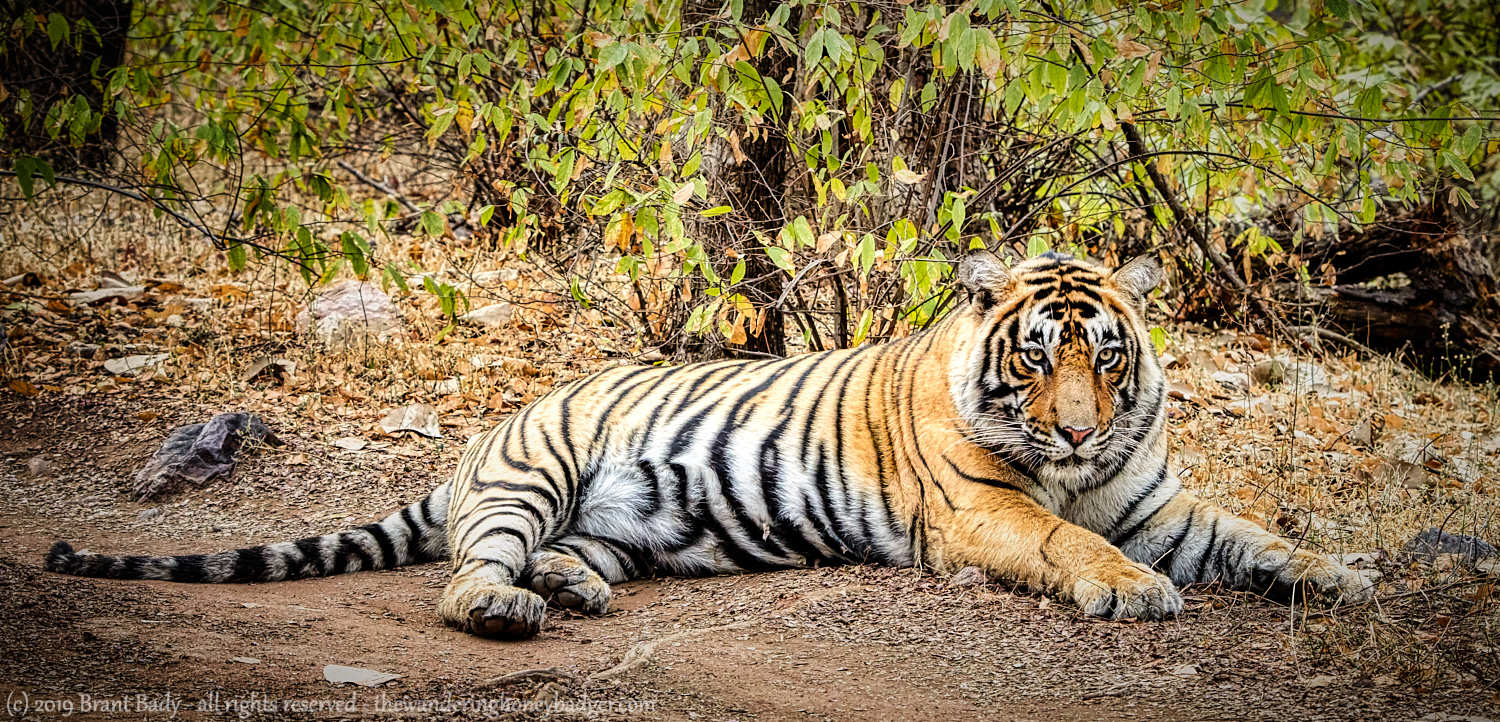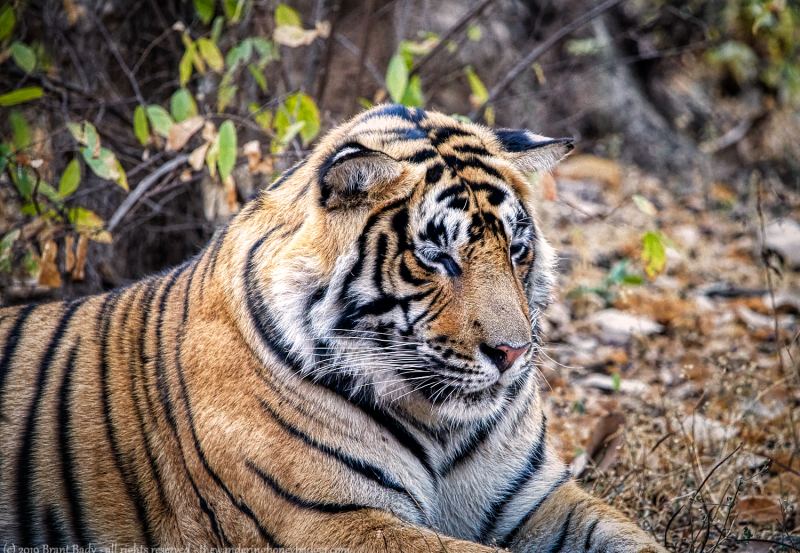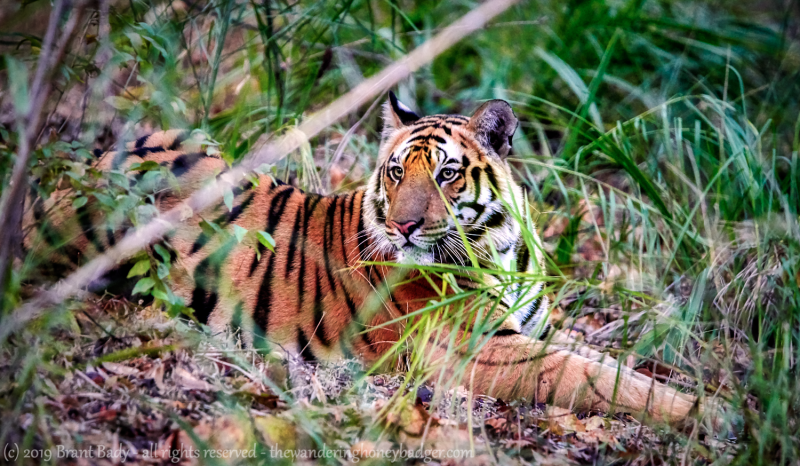
This is Part 1 of “On The Tiger Trail – How I Spent My Winter on Photo-Safaris in Northern India”
It wasn’t my first time on a tiger safari, nor my first trip to India, but this time it was considerably more satisfying and exciting than my previous attempt to see and photograph these magnificent animals. It definitely qualified as an adventure!
 Colour Aquatint by Samual Howet, 1807. Plate XVIII,
Colour Aquatint by Samual Howet, 1807. Plate XVIII,
Oriental Field Sports, Thomas Williamson, 1808
Looking back on it, my first tiger safari in India was short… Over the course of six safaris on that one visit, sadly only one tiger was sighted – visible for an all too brief “six minutes”.

However that first experience had left me with a palpable “taste for tiger”, and I most certainly wanted to see more despite my initial dubious luck. So this year I was going back, and this time I was armed with considerably more experience, knowledge and local contacts, and a plan to do nearly two-dozen safaris in India!
In fact, I had stalked almost all of the species of big cats for the purpose of photographing them at one point or another in recent years. These adventures occurred in various locations around the world, with varying degrees of success, for example having spent a few days looking for, but not spotting, a puma (cougar/mountain lion) in Patagonia. In contrast though, I was treated to a few tantalizing seconds of jaguar on the riverbank in Manu National Park in Peru, and given a limited glimpse of lounging leopards in Sri Lanka’s Yala National Park where an insane number of jeeps fought for a view.
Over the course of two weeks of safaris in African countries of Kenya and Tanzania that share the Serengeti, I had gorged on lion sightings to the point where it was almost passe’ – can you believe that I would actually start to turn my nose up a photographing “yet another lion”. Although cheetahs are not one of the five big cat species, they are abundant there on the Serengeti as well and are typically sighted alone, but sometimes in pairs or larger groups (for example the “five brothers” of Masai Mara who were inclined to hang out and hunt together).
Tanzania even provided a couple of sightings of leopards (one of my other favourite big cats, even if they are one of the smaller species). One lady leopard was kind enough to hang her recent kill of a gazelle in a tree one dusky evening, but then took off to hunt more. We gambled correctly by getting up very early in the morning and heading for her stash. Indeed, she had returned to snack upon her gazelle that she had left earlier, and was happily feasting even as we arrived. I can still hear the crunch of bones crackling in my auditory memory every time I revisit the photos I took.

Jaguar, Peru Lion, Tanzania Cheetahs, Kenya Leopard,Tanzania
Why Tigers, in India?
Tyger! Tyger! burning bright
In the forests of the night,
What immortal hand or eye
Could frame thy fearful symmetry? First stanza of William Blake’s “The Tyger”

It’s the eye of the tiger
It’s the thrill of the fight
Rising up to the challenge of our rival
And the last known survivor
Stalks his prey in the night
And he’s watching us all with the eye of the tiger – Survivor Lyrics from “Eye of the Tiger”
While some people think the phrase “eye of the tiger” originated with the band Survivor, and song by the same name as the phrase, but its use as an idiom pre-dates that. The “eyes of the tiger” refer to the large white spots on the back of every tiger’s ears, which actually fold backward when tigers are goes in for the kill/attack/under-threat – so that the last thing on earth the prey probably sees are those two white spots. If you see those “eyes” with the tiger facing you, you are about to die.
The other reason sometimes speculated for the rationale for those spots is to scare off anything trying to stalk it from behind, because they look like eyes of a bigger animal. Personally I think this is bunk, what predator is around that is going to take on a tiger even if it is an ambush from behind, except perhaps another tiger which would know which end of the other tiger is which. However, some forest workers in India rely on wearing human face masks on the back of their heads, under the rationale that the tigers would be less inclined to ambush them from behind if they think he was facing that way as well.

Image Credit: Ty Kamitz
In this case the tiger below is actually snoozing, but with his head sagging you can start to get a glimpse of the white spot on the back of each of his ears. I say “his” because, his name is Kumbha, or T-34 (meaning tiger 34).

This tiger is so famous he even has his own webpage of notations about markings and some tiger gossip – like which lady tigers he likes to hang around with, and how studly he is. Sorry Kumbha, the telephoto lens I used clearly adds 20 lbs to your apparent weight, and even if you are getting a touch paunchy in your midlife (as we all likely will), I am sure the ladies will still be giving you the chuff (tigers can’t purr, they “chuff” instead) and growl though.
Seriously though, tigers are particularly awesome animals:
- Tigers are the heaviest of all the big cats in weight and the longest in length (males weigh in at 400-675 pounds / 181-306 kg, on a body measuring 6-7.5 feet / 1.8-2.3 meters long)! Males are larger than females.
They have shoulders built like bodybuilders or WWF wrestlers, and sport claws up to 3.94 inches / 100mm in length. Tiger have fangs up to 3.5 inches / 90mm long.

Note: that would appear to be a chunk of deer meat caught on his RH side upper teeth, just below the fang.
A tiger’s sheer size and power commands your immediate attention, and they can and should strike fear into your heart if they reciprocate and give you, the observer/photographer, too much undo attention in return.
The “business end” of a tiger help makes them the most dangerous big cat in the world to humans: (For example, one female, the Champawat Tigeress, holds the world record for killing a staggering 436 people along the Nepal and Indian border at the turn of the Twentieth century.
There are nearly 10 times the number of lions versus tigers in the world, yet they both kill roughly the same number of people each year).
My personal thought is that almost any tiger except perhaps a cub could kill you in a single paw swipe if well targeted, and the bite would be sure to finish you off, yet they almost always ignore humans. Whereas leopards are quite frightened of humans, but they go out of their way to be TOTAL ninjas.. just watch one or more of the videos of leopard attacks in India out on youtube (BTW I view these as a kind of therapy when I get frustrated by traveling in India). The leopard is clearly scared out of its mind, but it doesn’t try to avoid conflict, it picks a path and anytime ANYONE gets within striking distance on that path, the leopard attacks by biting or mauling with its claws. It’s actually a counter productive strategy to its survival, unless of course it knows about guns. Anyways, it would seem that the take away is that leopards are more inclined to attack humans than tigers. In some regions of India, leopards actually kill more people than all other carnivores combined, so the numbers argue that leopards are far more dangerous to humans than tigers.
In truth, humans are not the natural prey of tigers, its typically older or sick animals who can’t hunt normally who turn to man-eating. But it seems that once the taste is acquired, it is persistent. A much more likely reason for a tiger attack is a tigress protecting her cubs, but that wouldn’t be for the purpose of feeding.
A colleague of mind shared an old photograph of a tiger a while back, and recounted the story about the tiger – which was huge in size to the point of corpulence, because it had turned into a man-eater, and it had killed three people already. When inquiring as to why the government had not yet destroyed the animal (the government had only tried to compensate the families), the park ranger replied “Well sir, in India, we have many many people, but not so many tigers”.
However despite their reputation, tigers can be much more elusive than some of the other big cats, but not so elusive that your odds are bad in seeing one fairly close in the wild. Snow Leopards are in that last category of being very difficult to observe, and I had turned down offers of photo expeditions to see them, mostly due to the extreme discomfort of low temperatures, and lots of strenuous hiking in snow.

So back to the original question – “Why Tigers?” – under the “Goldilocks Principle” of being “just right”, in my estimation at least, a photo safari in India in search of Bengal Tigers offers the best mix of: excitement versus challenge, comfort versus cost, and comparative odds for success.
See the link below to “On The Tiger Trail – Part 2” to learn about Where to Go, When to Go, How, and Safari Planning Tips…



